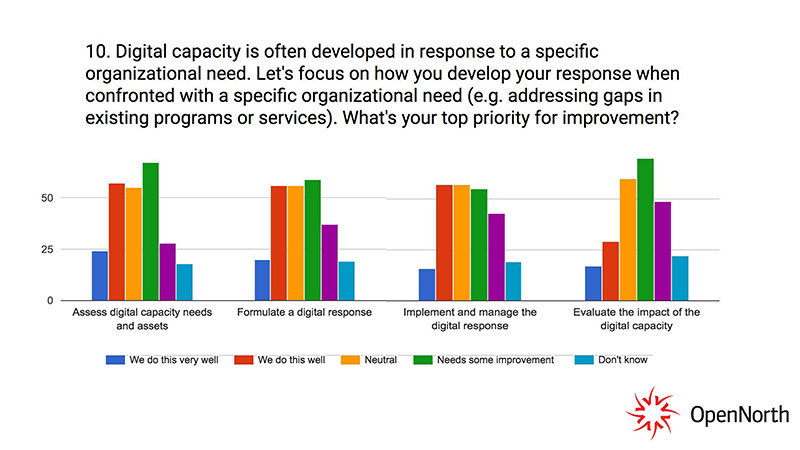Conducted in 2017, this follow-up research project funded by Immigration, Refugees and Citizenship Canada (IRCC) was designed to gain a deeper understanding of the digital capacity and needs of service provider organizations that serve newcomers in Canada and inform support recommendations for the sector. Open North collected the input of 261 newcomer settlement organizations with a primary data collection tool and presented its findings in a French and English webinar.
What is Digital Capacity?
According to the IRCC, Digital Capacity is:
“The ability to use digital tools within an organization to enhance service delivery, communication, and coordination. The digital capacity of an organization may be the function of skills and training (e.g. staff digital literacy), infrastructure (e.g. accessible internet, mobile hardware), applications (e.g. software, cloud computing) and processes (e.g. data analytics, data management, social media use).“
Research Objectives
- Gain a deeper understanding of the digital capacity and needs of service provider organizations (SPOs) that serve newcomers in Canada
- Help to inform and recommend options for future consideration to support the digital capacity of the settlement sector
- Help to fill a gap in evidence significant to policy development in the digital capacity area
- Support improvements to digital capacity among SPOs
Key Takeaways: Internal Tasks
- Email remains the predominant method that SPOs communicate internally, although there is significant use of cloud storage tools to manage most internal tasks;
- Social media, mainly Facebook, and communication tools usually applied for external communication purposes, like newsletters, also serve to manage staff (e.g. staff and volunteers) and build awareness of services;
- Notable use of video (41.8%) for organizational learning and development;
- While the great majority of SPOs rely on their website to conduct internal tasks, few have the capacity (or need) to use analytics;
- Easy to use SMS and text messaging tools are used frequently by SPOs, but the limited use of mobile apps is indicative of limited digital capacity.
Attitudes Toward Digital Capacity

Key Takeaways: External Tasks
- The majority of SPOs use their digital capacity to communicate externally to advertise events (90.7%), educate the public (89.5%), and recruit volunteers (71.4%);
- Opportunity for skills and training on fundraising (47.2%), although not all SPOs may share this need;
- Digital roles and responsibilities are shared (52.8%) within SPOs, reflecting a general use of digital tools, infrastructure, and processes
- Unclear which type/size of SPO have access to permanent internal capacity (46.4%);
- SPOs have an established web presence and widespread use of social media (Facebook, Twitter), and mailing lists and newsletters are standard external communication practices;
- While video is frequently used to communicate externally, there is a limited use of more technical applications of digital capacity, such as crowdsourcing, data visualization, mapping, or mobile apps.
See all the results from this digital capacity research project by reading the report below.